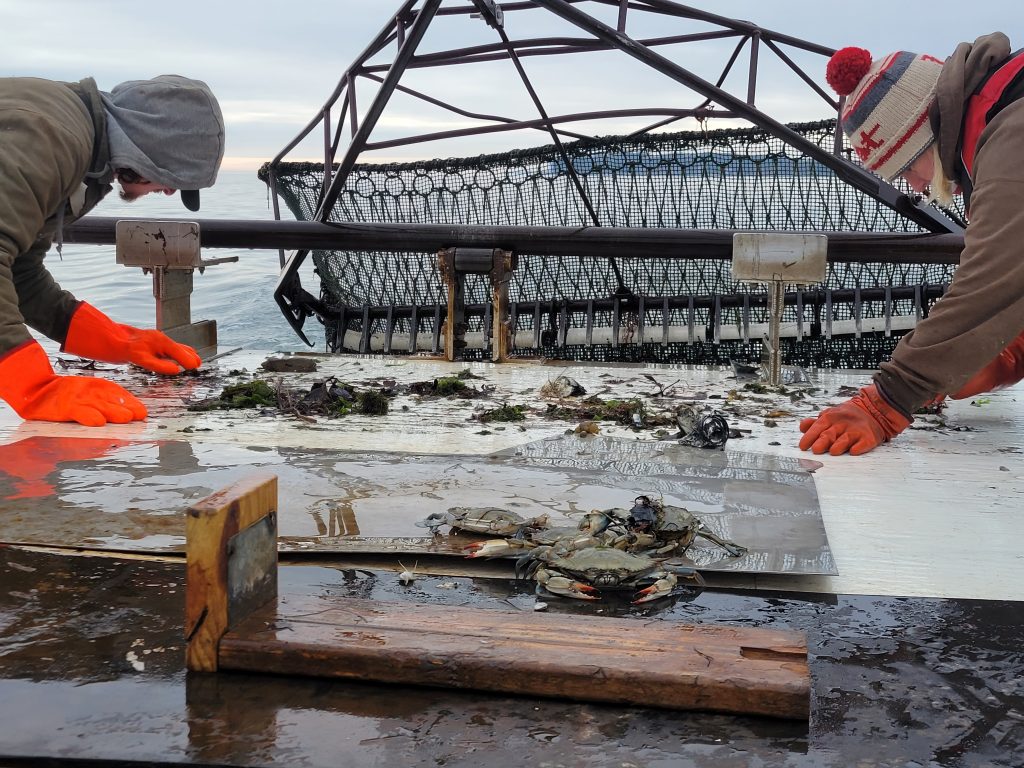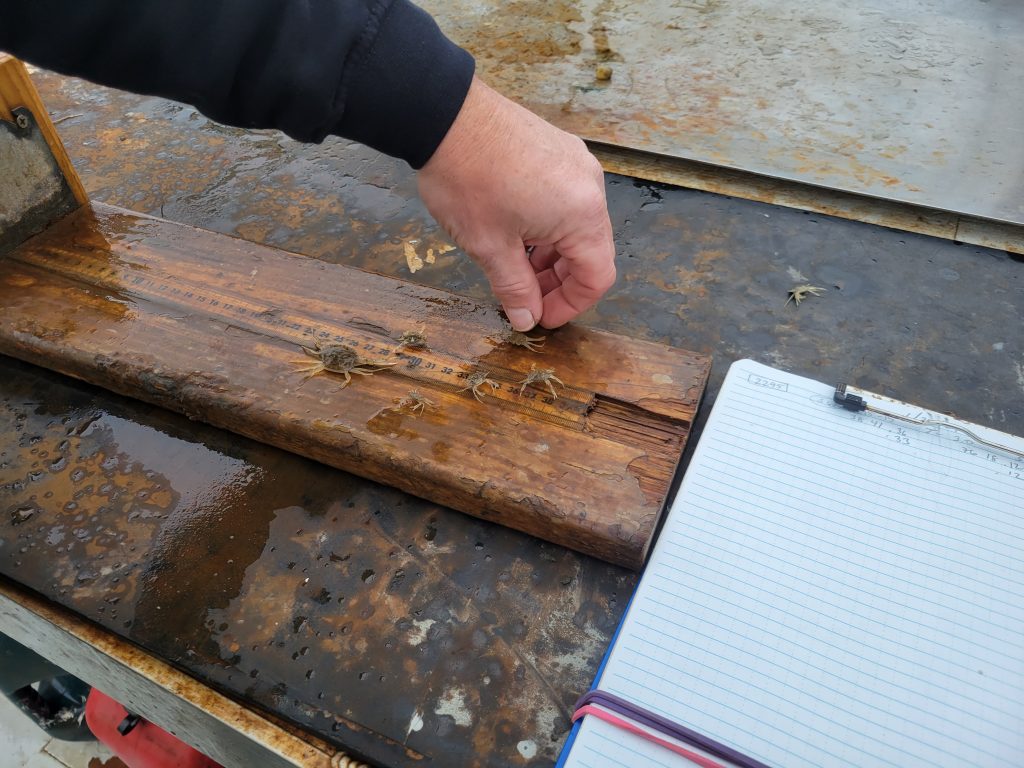Multi-year analysis to look at questions around juvenile recruitment, environmental factors

Crew on the winter dredge survey boat sort through blue crabs found in the Choptank River. Data from this survey will be included in the stock assessment. Photo by Joe Zimmermann, Maryland Department of Natural Resources
A team of researchers is preparing for a large-scale analysis of the blue crab population in the Chesapeake Bay that will help guide future management of the crab fishery and investigate factors that influence the animal’s survival and reproduction.
The stock assessment comes as a response to ongoing questions about the regional population of the iconic crustacean, particularly around the recent juvenile recruitment, or the amount of young crabs in the system. This number has been below average for five consecutive years, including the results of the 2024 blue crab winter dredge survey.
“One of the big reasons we’re doing the stock assessment is that recruitment hasn’t been as good as we expected based on the last assessment,” said Mike Wilberg, a professor at the University of Maryland Center for Environmental Science who is leading the assessment. “We want to take a look at this and figure out why things aren’t going the way we expect.”
Stock assessments are a common method that fishery managers use to examine the historic and current condition of a species and produce estimates for a sustainable harvest. It also determines reference points that are benchmarks of a healthy population to guide management.
A multi-year effort that takes in extensive amounts of data, the stock assessment is set to be completed and published in March 2026. Planning began in 2022, and the team will begin preliminary data analysis and model development this summer, before developing the final model and putting the assessment through peer review in late 2025.
This project intends to expand and improve upon the 2011 stock assessment on blue crabs in the Chesapeake Bay, which Wilberg describes as “about seven blue crab generations ago.”
Mandy Bromilow, DNR’s blue crab program manager, said a lot has changed in that time, and there hasn’t been an overall reexamination of the data that contributed to the last assessment.
“We haven’t had a real evaluation of the assumptions we have in the model, and there are new analytical methods that could be applied to the data,” she said. “We want to look at the data and techniques to make sure we’re using the best models and data to assess the blue crab population.”
The 2011 assessment helped establish reference points for female blue crabs, or sooks. Maryland and Virginia regulations restricted the harvest of female blue crabs in the Chesapeake Bay because of these findings and the importance of females for the reproductive success of the species.
Wilberg said this previous assessment may have been “overly optimistic,” and Glenn Davis, a DNR fisheries biologist that conducts data analysis on blue crabs, said the new assessment might look at establishing reference points for male crabs as well as considering other factors.
“I think there’s a lot of hope and a lot of potential to broaden the scope of the assessment and figure out some of these things, like habitat, ocean currents, or predation, that may have contributed to the failure of the recruitment in recent years,” Davis said. “These are things that have developed or changed a lot in the past 10 years.”

A Maryland DNR biologist gathers juvenile blue crabs for measurement in the 2024 winter dredge survey. The abundance of juveniles has been a concern for scientists in recent years. Photo by Joe Zimmermann, Maryland DNR
The Chesapeake Bay Stock Assessment Committee held a 2022 workshop that identified environmental factors warranting analysis in the stock assessment, including hypoxia, water temperature, habitat availability, and predation.
Wilberg said the effects of invasive blue catfish are “on the top of my mind.” A 2023 VIMS study estimated that blue catfish prey on 441 tons of blue crab in the James River alone each year. The stock assessment team will look at survey data and abundance of blue catfish, as well as evaluating the percentage of the blue crab population that might be prey to these invasives.
“The study that VIMS did definitely shows that blue cats are eating a lot of blue crabs,” he said. “There’s no question they eat blue crabs, we just don’t know if they have a Bay-wide effect.”
The stock assessment involves researchers from several research institutions and government groups across Maryland and Virginia, including the Maryland Department of Natural Resources (DNR), the Virginia Institute of Marine Science (VIMS), the Smithsonian Environmental Research Center, Morgan State University, the Virginia Marine Resources Commission, and the Potomac River Fisheries Commission.
The undertaking won’t involve collecting new data, but will instead consist of combing through vast quantities of existing information and creating models that will identify patterns and associations.
In what Wilberg described as a “leaving no stone unturned” approach, data sets will come from the Maryland DNR and VIMS winter dredge survey for blue crabs, as well as the VIMS’ trawl survey, harvest data, Maryland sentinel fishery data and many other sources. Wilberg said the stock assessment will take into account data from at least the 1990s, but it may go as far back as catch data from the 1950s and VIMS survey data from the 1960s.
“Either way, that is a large sample,” said Wilberg, who previously was engaged by DNR to lead Maryland’s oyster stock assessment. “Especially considering most blue crabs don’t live more than two years, we get a really good snapshot of how the population is changing.”
While the stock assessment may not provide all the answers about what is affecting blue crabs, it should provide a path forward for management, Wilberg said.
“The main goal with this stock assessment is to try to develop better reference points for sustainable management of blue crabs—how many blue crabs should we have in the water, which relates to how many we can harvest,” he said. “It might give us a better idea of what to expect for the next 10 years in the fishery.”
By Joe Zimmermann, science writer with the Maryland Department of Natural Resources
